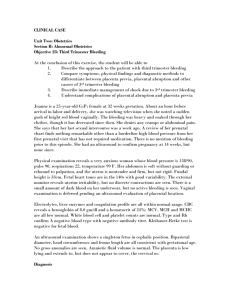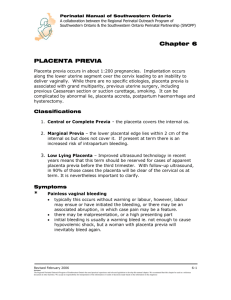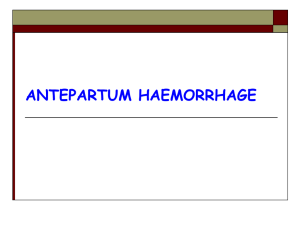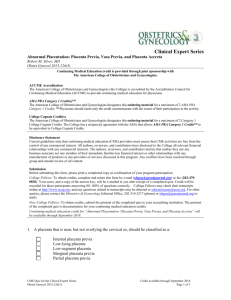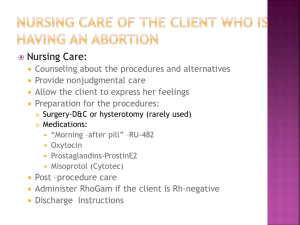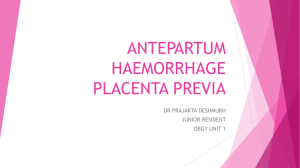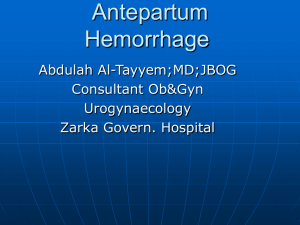Placenta Previa
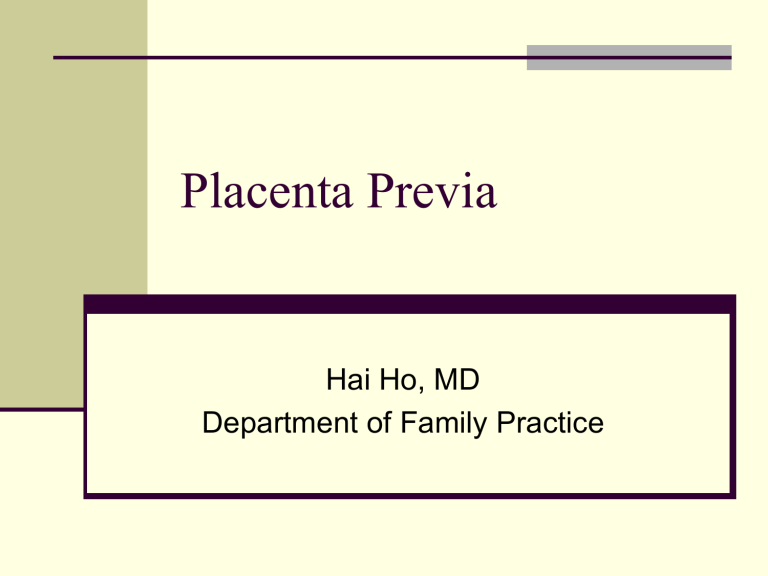
Placenta Previa
Hai Ho, MD
Department of Family Practice
What is placenta previa?
Implantation of placenta over cervical os
Types of placenta previa
Who are at risk for placenta previa?
Endometrial scarring of upper segment of uterus – implantation in lower uterine segment
Prior D&C or C-section
Multiparity
Advance age – independent risk factor vs. multiparity
Who are at risk for placenta previa?
Reduction in uteroplacental oxygen or nutrient delivery – compensation by increasing placental surface area
Male
High altitude
Maternal smoking
Factors that determine persistence of placenta previa?
Time of diagnosis or onset of symptoms
Location of placenta previa
Repeat ultrasound at 24 – 28 weeks’ gestation
Clinical presentations?
Painless vaginal bleeding – 70-80%
1/3 prior to 30 weeks
Mostly during third trimester – shearing force from lower uterine segment growth and cervical dilation
Sexual intercourse
Uterine contraction – 10-20%
Fetal complications?
Malpresentation
Preterm premature rupture of membrane
Diagnostic test?
Ultrasound
Placenta Previa: ultrasound
Placenta
Placenta Previa: ultrasound
Placenta accreta?
Abnormal attachment of the placenta to the uterine wall (decidua) such that the chorionic villi invade abnormally into the myometrium
Primary deficiency of or secondary loss of decidual elements (decidua basalis)
Associated with placenta previa in 5-10% of the case
Proportional to the number of prior Cesarean sections
Variations of placenta accreta
Placenta accreta: ultrasound
Vasa Previa?
Vasa Previa
Vasa Previa
Vasa Previa
Vasa Previa
Rupture
Compression of vessels
Perinatal mortality rate – 50 – 75%
Management of placenta previa?
Individualized based on (not much evidence):
Gestational age
Amount of bleeding
Fetal condition and presentation
Preterm with minimal or resolved bleeding
Expectant management – bed rest with bathroom privilege
Periodic maternal hematocrit
Prophylactic transfusion to maintain hematocrit > 30% only with continuous lowgrade bleeding with falling hematocrit unresponsive to iron therapy
Preterm with minimal or resolved bleeding
Fetal heart rate monitoring only with active bleeding
Ultrasound every 3 weeks – fetal growth, AFI, placenta location
Rhogam for RhD-negative mother
Preterm with minimal or resolved bleeding
Amniocentesis weekly starting at 36 weeks to assess lung maturity – delivered when lungs reach maturity
Betamethasone or dexamethasone between
24 – 34 weeks’ gestation to enhance lung maturity
Tocolysis – magnesium sulfate
Active bleeding
Stabilize mother hemodynamically
Deliver by Cesarean section
Rhogam in Rh-negative mother
Betamethasone or dexamethasone between
24 – 34 weeks’ gestation to enhance lung maturity
Management of placenta previa
No large clinical trials for the recommendations
Consider hospitalization in third-trimester
Antepartum fetal surveillance
Corticosteroid for lung maturity
Delivery at 3637 weeks’ gestation
Management of placenta accreta
Cesarean hysterectomy
Uterine conservation
Placental removal and oversewing uterine defect
Localized resection and uterine repair
Leaving the placenta in situ and treat with antibiotics and removing it later
Placenta Abruption
What is placental abruption?
Premature separation of placenta from the uterus
Epidemiology
Incident 1 in 86 to 1 in 206 births
One-third of all antepartum bleeding
Pathogenesis
Maternal vascular disruption in decidua basalis
Acute versus chronic
Types of placental abruption
16%
81%
4%
Types of placenta hemorrhage
Risk factors for placental abruption?
Maternal hypertension
Maternal age and parity – conflicting data
Blunt trauma – motor vehicle accident and maternal battering
Tobacco smoking and cocaine
Risk factors for placental abruption
Prior history of placental abruption
5-15% recurrence
After 2 consecutive abruptions, 25% recurrence
Sudden decompression of uterus in polyhydramnios or multiple gestation (after first twin delivery) – rare
Thrombophilia such as factor V Leiden mutation
Clinical presentations?
± Vaginal bleeding
Uterine contraction or tetany and pain
Abdominal pain
DIC
10-20% of placental abruption
Associated with fetal demise
Fetal compromise
Diagnostic test?
Ultrasound
Sensitivity ~ 50%
Miss in acute phase because blood could be isoechoic compared to placenta
Hematoma resolution – hypoechoic in 1 week and sonolucent in 2 weeks
Blood tests
Ultrasound: subchorionic abruption
Ultrasound: retroplacental abruption
Ultrasound: retroplacental abruption
Blood tests?
CBC – hemoglobin and platelets
Fibrinogen
Normal 450 mg/dL
<150 mg/dL – severe DIC
Fibrin degradation products
PT and PTT
Management?
Hemodynamic monitoring
Urine output with Foley
BP drop – late stage, 2-3 liter of blood loss
Fetal monitoring
Management: delivery
Timing
Severity of placental abruption
Fetal maturity - consider tocolysis with MgSO
4 and corticosteroid (24-34 weeks)
Correction of DIC with transfusion of PRBC,
FFP, platelets to maintain hematocrit > 25%, fibrinogen >150-200 mg/dL, and platelets >
60,000/m 3
Mode: vaginal vs. Cesarean-section
Couvelaire uterus?
Bleeding into myometrium leading to uterine atony and hemorrhage
Treatment
Most respond to oxytocin and methergine
Hysterectomy for uncontrolled bleeding
